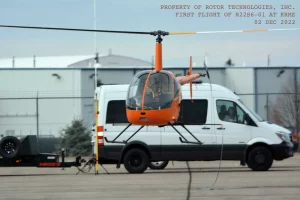Rotor Technologies, Inc.’s prototype of a firefighting helicopter drone successfully executed its first flight on December 2, 2022 at the FAA’s New York UAS test site after receiving experimental certification on November 30, 2022.
Continue reading below, or listen:
Rotor Inc. isn’t a hardware manufacturer. The team of MIT scientists have combined flight control algorithms, computer vision, and satellite communications to create CloudPilot, an operating system that can remotely pilot traditionally manufactured aircraft. From the NUAIR press release:
Using CloudPilot, a pilot can “teleoperate” a helicopter from anywhere in the world. The system uses commercial Low Earth Orbit satellite constellations such as SpaceX’s StarLink to transfer data over long distances with minimal delay. Proprietary VR technology gives pilots better visibility than the cockpit, enabling operations at night and in low visibility and preventing accidents caused by pilot disorientation and human error — such as the Kobe Bryant tragedy.
The prototype helicopter pictured is based on the Robinson R22, a light helicopter mostly used for flight training and agriculture. (The official name is R22S6–01, the Rotor team named it “Birdy McBird Face.”) With a pilot, the R22 has a payload of approximately 170lbs. Without a pilot, Birdy McBird Face can carry a payload of 400lbs for more than 3 hours. This makes the CloudPilot systems ideal for fighting wildfires, where helicopters are commonly flown for delivering fire retardant, and Rotor is working with federal and state agencies on field testing in 2023 for firefighting.
The initial flight on 2 December, 2022 verified the functioning of Rotor’s flight controls, engine controls, and teleoperations systems. The pilot was located in a ground control station and directly manipulated the flight controls throughout the flight, providing real-time inputs to stabilize the helicopter. Communications from the helicopter and control station were transmitted over multiple digital radio links, while a wired tether provided a fail-safe backup.
The prototype was operated in low hover within visual line of sight of the pilot. The longest flight of the day was a little over 3 minutes long. These flights gathered data to support flight controls development and flight envelope expansion.
Miriam McNabb is the Editor-in-Chief of DRONELIFE and CEO of JobForDrones, a professional drone services marketplace, and a fascinated observer of the emerging drone industry and the regulatory environment for drones. Miriam has penned over 3,000 articles focused on the commercial drone space and is an international speaker and recognized figure in the industry. Miriam has a degree from the University of Chicago and over 20 years of experience in high tech sales and marketing for new technologies.
For drone industry consulting or writing, Email Miriam.
TWITTER:@spaldingbarker
Subscribe to DroneLife here.
https://dronelife.com/2022/12/19/firefighting-helicopter-drone-takes-first-flight-at-faas-ny-test-site/
